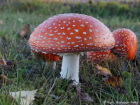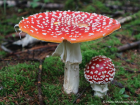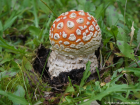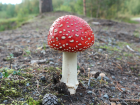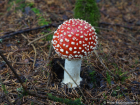Cap first round to hemispherical, and finally to plate-like and flat in mature specimens, often with a low, shallow depression on disk when fully expanded. Surface shiny, deep scarlet, fading to orange-red or orange-yellow in older specimens, adorned with numerous small, cottony warts that are initially yellow but very quickly fade to white. Gills white, free or barely touching the stem, crowded. Stem white, robust, and has a slightly brittle, fibrous texture. At the base is a bulb that bears universal veil remnants in the form of two to four distinct rings or ruffs. Between the basal universal veil, remnants and gills are remnants of the partial veil (which covers the gills during development) in the form of a white ring. It can be quite wide and flaccid with age. Spore print white.
Microscopic Features: The spores are ellipsoidal in shape and measure 8.2-13 μm in length and 6.5-9 μm in width. They are inamyloid.
Amanita muscaria on the First Nature Web site.
Amanita muscaria var. flavivolvata on the MushroomExpert.Com Web site.
Many mushrooms are poisonous, and some can be lethally toxic. Distinguishing between edible and poisonous mushrooms can be very challenging. Therefore, we strongly advise against consuming wild mushrooms. This website does not contain any information about the edibility or toxicity of mushrooms.
Although efforts have been made to ensure accuracy on this website, the information may contain errors and omissions. Therefore, all content provided is for educational and informational purposes only and should not be relied upon or used as a basis for consuming any plants or mushrooms.
External links are provided for reference only. We do not endorse or take responsibility for the content, advice, or products found on these sites or in any advertisements shown on this website.
